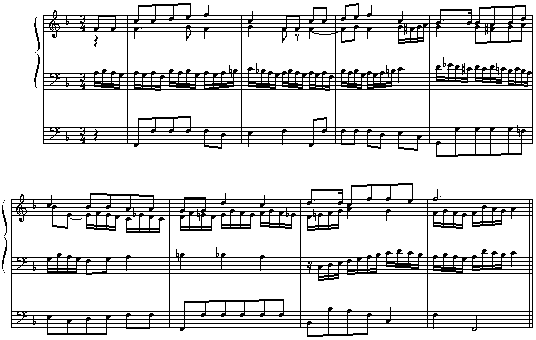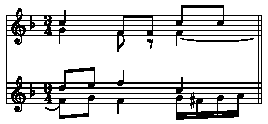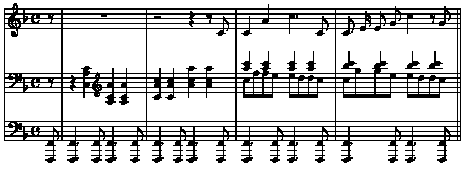
Example 29.3-1.

29.4. If measures are numbered in the print text, the numbers (written in the upper part of the cell without numeral prefix) must be placed between the measures with a blank space on either side.
Example 29.4-1.
 etc.
etc.
29.5. The first measure in a section does not require a number, since this number is given in the heading of the section (see below).
29.6. A free line must be left above the first line of each section. In this line the serial number of the section, the numbers of the measures contained in that section, and the numbers of the print page and stave (or staves) for that section must be centralized in this order. The measure numbers are written in the lower part of the cell and are separated from each other by dots 36; the page and stave numbers are written in the upper part of the cell (preceded by the sign "3 ) and are separated from each other by dot 3. If more than one stave is indicated, the stave numbers are separated from each other by the sign
- .
Example 29.6-1.#A #1-8 "3#A,A
(a)
(b)
29.12. A further method of abbreviation is by the use of the "segno". This differs from partial abbreviation in two ways: (a) the passage to be repeated may be of any length providing it does not exceed the length of a section; (b) the repetition may be at any distance from the original passage.
29.13. In vocal music, the measures must be numbered, and the number of the first measure in each section must be placed at the commencement of the first line of words in that section. <.C
#A #0-8' "3#A'A
(Section 1, beginning with incomplete measure, ending in the middle of measure 8, page 1, stave 1.)
When sections are arranged independently of the print staves, a change of stave is shown by the sign 3l placed between measures.
Example 29.8-1.
<#C4
.>.?"GG.DD<>"\GX]@C 3L .EF]?<>"GH]"
"(%GHI<K

If the measures are numbered, the measure number follows this sign.
29.10. Music shared between the hands should be treated as shown in Par. 20.4-20.4.1.
29.11. As measures numbers should always be given in the section heading, the system of repeats by measure numbers explained in Par. 16.23.1-16.24.1 is recommended for this style.
29.14. In vocal accompaniments, an outline of the voice part should be included to assist the player in memorizing his part; the voice part must be given after an in-accord sign in the right-hand part, the sign "> being marked in every measure. Only notes, ties and rests should be given in this outline.
Example 29.14-1.
.>'X"1">'X V"?+-"[0-7<>">'M .?+-7"
.[0-7<>">'UVX"D ;?+777<>.DGGFFE"
.ED<>">"?"[?'"D ;?/777<>.DHHFFEED<>
">"D'&FH.?X"H<K
_>@G- ]'-G-7 7#C<K
